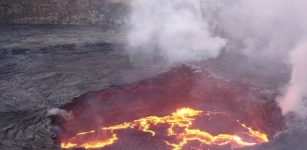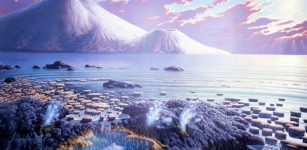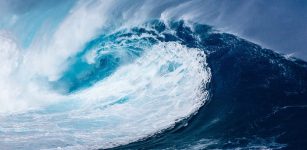Why Are Some Antarctic Icebergs Green?
Eddie Gonzales Jr. – MessageToEagle.com – Since the early 1900s explorers and sailors have reported seeing peculiar green icebergs around certain parts of Antarctica. The green icebergs have been a curiosity to scientists for decades and it seems researchers can now offer an explanation why some of these icebergs are tinged emerald green rather than the normal blue.
Pure ice is blue because ice absorbs more red light than blue light, but where does the green color come from?
A green iceberg sighted in the Weddell Sea, Antarctica on February 16th, 1985. Credit: AGU/Journal of Geophysical Research: Oceans/Kipfstuhl et al 1992.
After discovering large amounts of iron in East Antarctica’s Amery Ice Shelf, researchers have developed a new theory that suggests iron oxides in rock dust from Antarctica’s mainland are turning some icebergs green.
Iron is a key nutrient for phytoplankton, microscopic plants that form the base of the marine food web, but there are not large amounts of iron in many areas of the ocean.
In a new study published in the Journal of Geophysical Research: Oceans, a journal of the American Geophysical Union, geologists say if their new theory is correct, it would mean green icebergs are ferrying precious iron from Antarctica’s mainland to the open sea when they break off, providing this key nutrient to the organisms that support nearly all marine life.
“It’s like taking a package to the post office. The iceberg can deliver this iron out into the ocean far away, and then melt and deliver it to the phytoplankton that can use it as a nutrient. We always thought green icebergs were just an exotic curiosity, but now we think they may actually be important,” said Stephen Warren, a glaciologist at the University of Washington and lead author of the new study said in a press statement.
Warren started studying the phenomenon on an Australian expedition in 1988, when he took a core sample from a green iceberg near the Amery Ice Shelf on the coast of East Antarctica.
Interestingly, the green ice he saw was a deep emerald hue much darker and clearer than that of normal icebergs – a signal to scientists that green ice might be different from regular iceberg ice.
“When we climbed up on that iceberg, the most amazing thing was actually not the color but rather the clarity,” Warren said. “This ice had no bubbles. It was obvious that it was not ordinary glacier ice.”
See also:
Intriguing Study: Climate Change Does Not Affect All Glaciers Of Antarctica
Antarctica Loses Six Times More Ice Mass Annually Now Than 40 Years Ago
Previously Undetected Huge Subglacial Valleys And Mountains Discovered Near Antarctica’s South Pole
Icebergs break off of glaciers and ice shelves that jut out into the sea. Typical glacier ice forms when layers of snow build up and solidify over time, so it naturally has air pockets that reflect light.
But in Antarctica, some icebergs have a layer of what’s called marine ice: ocean water frozen to the underside of an overhanging ice shelf. Marine ice is clearer and darker than glacier ice because it doesn’t have any air pockets to reflect light.
Analysis of that iceberg and other green icebergs revealed that green parts were made of marine ice and not glacier ice. They suspected an impurity in the ocean water underneath the Amery Ice Shelf was turning some marine ice green, but this was not the case.
A while back, an oceanographer at the University of Tasmania tested an ice core from the Amery Ice Shelf for its iron content. She found marine ice near the bottom of the core had nearly 500 times more iron than the glacial ice above.
Researchers on top of a large composite iceberg in October 1996. Credit: Collin Roesler.
Iron oxides found in soil, rocks, and common rust tend to have warm, earthy hues – yellows, oranges, reds and browns. Warren started to suspect iron oxides in the marine ice could turning blue ice green, but where was the iron coming from?
As glaciers flow over bedrock, they grind rocks to a fine powder known as glacial flour. When the ice meets the sea, this glacial flour flows into the ocean. If the rock dust becomes trapped under an ice shelf, the particles could be incorporated in marine ice as it forms.
Warren now thinks iron oxides in glacial flour from rocks on Antarctica’s mainland are responsible for creating the stunning emerald icebergs. To confirm this theory, he and the Australian iron researchers now propose to sample icebergs of different colors for their iron content and light-reflecting properties. If their theory proves correct, green icebergs could be more important than scientists thought.
Perhaps scientists have finally solved the mystery of the green Antarctic icebergs.
Written by Eddie Gonzales Jr. – MessageToEagle.com Staff Writer












